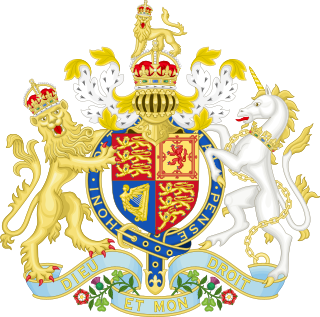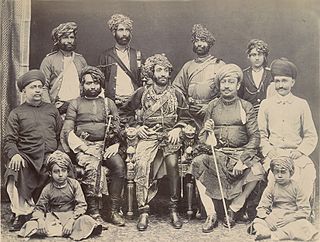Related Research Articles

His Majesty's Principal Secretary of State for India, known for short as the India secretary or the Indian secretary, was the British Cabinet minister and the political head of the India Office responsible for the governance of the British Indian Empire, including Aden, Burma and the Persian Gulf Residency. The post was created in 1858 when the East India Company's rule in Bengal ended and India, except for the Princely States, was brought under the direct administration of the government in Whitehall in London, beginning the official colonial period under the British Empire.

The governor-general of India was the representative of the monarch of the United Kingdom in their capacity as the Emperor/Empress of India and after Indian independence in 1947, the representative of the Monarch of India. The office was created in 1773, with the title of Governor-General of the Presidency of Fort William. The officer had direct control only over his presidency but supervised other East India Company officials in India. Complete authority over all of British territory in the Indian subcontinent was granted in 1833, and the official came to be known as the "Governor-General of India".
The doctrine of lapsation was a policy of annexation initiated by the East India Company in the Indian subcontinent for the princely states, and applied until the year 1858, the year after Company rule was succeeded by the British Raj under the British Crown.

A princely state was a nominally sovereign entity of the British Indian Empire that was not directly governed by the British, but rather by an Indian ruler under a form of indirect rule, subject to a subsidiary alliance and the suzerainty or paramountcy of the British crown.
Suzerainty includes the rights and obligations of a person, state, or other polity which controls the foreign policy and relations of a tributary state but allows the tributary state internal autonomy. Where the subordinate party is called a vassal, vassal state, or tributary state, the dominant party is called a suzerain. The rights and obligations of a vassal are called vassalage, and the rights and obligations of a suzerain are called suzerainty.

The Government of India Act 1935 was an act passed by the British Parliament that originally received royal assent in August 1935. It was the longest act that the British Parliament ever enacted until the Greater London Authority Act 1999 surpassed it. Because of its length, the act was retroactively split by the Government of India (Reprinting) Act 1935 into two separate acts:

The Instrument of Accession was a legal document first introduced by the Government of India Act 1935 and used in 1947 to enable each of the rulers of the princely states under British paramountcy to join one of the new dominions of India or Pakistan created by the Partition of British India.

The Dominion of India, officially the Union of India, was an independent dominion in the British Commonwealth of Nations existing between 15 August 1947 and 26 January 1950. Until its independence, India had been ruled as an informal empire by the United Kingdom. The empire, also called the British Raj and sometimes the British Indian Empire, consisted of regions, collectively called British India, that were directly administered by the British government, and regions, called the princely states, that were ruled by Indian rulers under a system of paramountcy. The Dominion of India was formalised by the passage of the Indian Independence Act 1947, which also formalised an independent Dominion of Pakistan—comprising the regions of British India that are today Pakistan and Bangladesh. The Dominion of India remained "India" in common parlance but was geographically reduced. Under the Act, the British government relinquished all responsibility for administering its former territories. The government also revoked its treaty rights with the rulers of the princely states and advised them to join in a political union with India or Pakistan. Accordingly, the British monarch's regnal title, "Emperor of India," was abandoned.

Before India gained independence in 1947, India was divided into two sets of territories, one under direct British rule, and the other consisting of princely states under the suzerainty of the British Crown, with control over their internal affairs remaining in the hands of their hereditary rulers. The latter included 562 princely states which had different types of revenue-sharing arrangements with the British, often depending on their size, population and local conditions. In addition, there were several colonial enclaves controlled by France and Portugal. After independence, the political integration of these territories into an Indian Union was a declared objective of the Indian National Congress, and the Government of India pursued this over the next decade.

The provinces of India, earlier presidencies of British India and still earlier, presidency towns, were the administrative divisions of British governance on the Indian subcontinent. Collectively, they have been called British India. In one form or another, they existed between 1612 and 1947, conventionally divided into three historical periods:

The British Raj was the rule of the British Crown on the Indian subcontinent, lasting from 1858 to 1947. It is also called Crown rule in India, or Direct rule in India. The region under British control was commonly called India in contemporaneous usage and included areas directly administered by the United Kingdom, which were collectively called British India, and areas ruled by indigenous rulers, but under British paramountcy, called the princely states. The region was sometimes called the Indian Empire, though not officially.

Sir Spencer Harcourt Butler was an officer of the Indian Civil Service who was the leading British official in Burma for much of his career, serving as Lieutenant-Governor and later Governor of Burma (1923–27).

The Chamber of Princes was an institution established in 1920 by a royal proclamation of King-Emperor George V to provide a forum in which the rulers of the princely states of India could voice their needs and aspirations to the colonial government of British India. It survived until the end of the British Raj in 1947.
The Darbhanga Raj, also known as Raj Darbhanga and the Khandwala dynasty, was a Maithil Brahmin dynasty and the rulers of territories, not all contiguous, that were part of the Mithila region, now divided between India and Nepal.

After the Indian Rebellion of 1857, the British Government took over the administration to establish the British Raj. The British Raj was the period of British Parliament rule on the Indian subcontinent between 1858 and 1947, for around 89 years of British occupation. The system of governance was instituted in 1858 when the rule of the East India Company was transferred to the Crown in the person of Queen Victoria.

Jammu and Kashmir, also known as Kashmir and Jammu, was a princely state in a subsidiary alliance with the British East India Company from 1846 to 1858 and under the paramountcy of the British Crown, from 1858 until the Partition of India in 1947, when it became a disputed territory, now administered by three countries: China, India, and Pakistan. The princely state was created after the First Anglo-Sikh War, when the East India Company, which had annexed the Kashmir Valley, from the Sikhs as war indemnity, then sold it to the Raja of Jammu, Gulab Singh, for rupees 75 lakhs.

The Baroda Crisis was a political crisis took place in British India between 1872 and 1876 in Baroda, a 21-gun-salute Gujarati princely state.
British protectorates were protectorates—or client states—under protection of the British Empire's armed forces and represented by British diplomats in international arenas, such as the Great Game, in which the Emirate of Afghanistan and the Tibetan Kingdom became protected states for short periods of time. Many territories which became British protectorates already had local rulers with whom the Crown negotiated through treaty, acknowledging their status whilst simultaneously offering protection, e.g. British Paramountcy. British protectorates were therefore governed by indirect rule. In most cases, the local ruler, as well as the subjects of the indigenous ruler were not British subjects. British protected states represented a more loose form of British suzerainty, where the local rulers retained absolute control over the states' internal affairs and the British exercised control over defence and foreign affairs.

Nawab of Junagarh or Junagadh refers to the now defunct ex-lineage of rulers of the princely Junagarh State in British Raj, nowadays Junagadh district in the state of Gujarat in India. There are still several forts and palaces in India which were owned by princely Junagarh family but after Partition of India, this property was claimed by the Indian Government.
Sir Frank Herbert Brown CIE (1868–1959) was an English journalist, on the editorial staff of The Times from 1929 to 1954. He was a recognised authority on Indian affairs.
References
- A Brief History of Modern India, by Rajiv Ahir I.P.S Spectrum Publications Pg 605,606 Edition 2019-20.